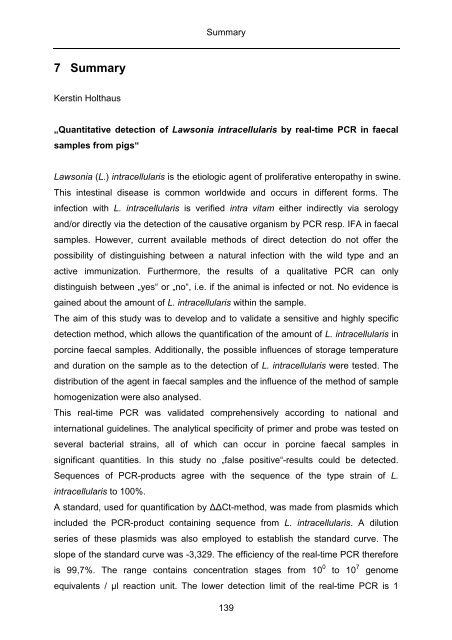Quantitativer Nachweis von Lawsonia intracellularis mittels real-time ...
Quantitativer Nachweis von Lawsonia intracellularis mittels real-time ...
Quantitativer Nachweis von Lawsonia intracellularis mittels real-time ...
Erfolgreiche ePaper selbst erstellen
Machen Sie aus Ihren PDF Publikationen ein blätterbares Flipbook mit unserer einzigartigen Google optimierten e-Paper Software.
7 Summary<br />
Kerstin Holthaus<br />
Summary<br />
„Quantitative detection of <strong>Lawsonia</strong> <strong>intracellularis</strong> by <strong>real</strong>-<strong>time</strong> PCR in faecal<br />
samples from pigs“<br />
<strong>Lawsonia</strong> (L.) <strong>intracellularis</strong> is the etiologic agent of proliferative enteropathy in swine.<br />
This intestinal disease is common worldwide and occurs in different forms. The<br />
infection with L. <strong>intracellularis</strong> is verified intra vitam either indirectly via serology<br />
and/or directly via the detection of the causative organism by PCR resp. IFA in faecal<br />
samples. However, current available methods of direct detection do not offer the<br />
possibility of distinguishing between a natural infection with the wild type and an<br />
active immunization. Furthermore, the results of a qualitative PCR can only<br />
distinguish between „yes“ or „no“, i.e. if the animal is infected or not. No evidence is<br />
gained about the amount of L. <strong>intracellularis</strong> within the sample.<br />
The aim of this study was to develop and to validate a sensitive and highly specific<br />
detection method, which allows the quantification of the amount of L. <strong>intracellularis</strong> in<br />
porcine faecal samples. Additionally, the possible influences of storage temperature<br />
and duration on the sample as to the detection of L. <strong>intracellularis</strong> were tested. The<br />
distribution of the agent in faecal samples and the influence of the method of sample<br />
homogenization were also analysed.<br />
This <strong>real</strong>-<strong>time</strong> PCR was validated comprehensively according to national and<br />
international guidelines. The analytical specificity of primer and probe was tested on<br />
several bacterial strains, all of which can occur in porcine faecal samples in<br />
significant quantities. In this study no „false positive“-results could be detected.<br />
Sequences of PCR-products agree with the sequence of the type strain of L.<br />
<strong>intracellularis</strong> to 100%.<br />
A standard, used for quantification by ∆∆Ct-method, was made from plasmids which<br />
included the PCR-product containing sequence from L. <strong>intracellularis</strong>. A dilution<br />
series of these plasmids was also employed to establish the standard curve. The<br />
slope of the standard curve was -3,329. The efficiency of the <strong>real</strong>-<strong>time</strong> PCR therefore<br />
is 99,7%. The range contains concentration stages from 10 0 to 10 7 genome<br />
equivalents / µl reaction unit. The lower detection limit of the <strong>real</strong>-<strong>time</strong> PCR is 1<br />
139










![Tmnsudation.] - TiHo Bibliothek elib](https://img.yumpu.com/23369022/1/174x260/tmnsudation-tiho-bibliothek-elib.jpg?quality=85)






